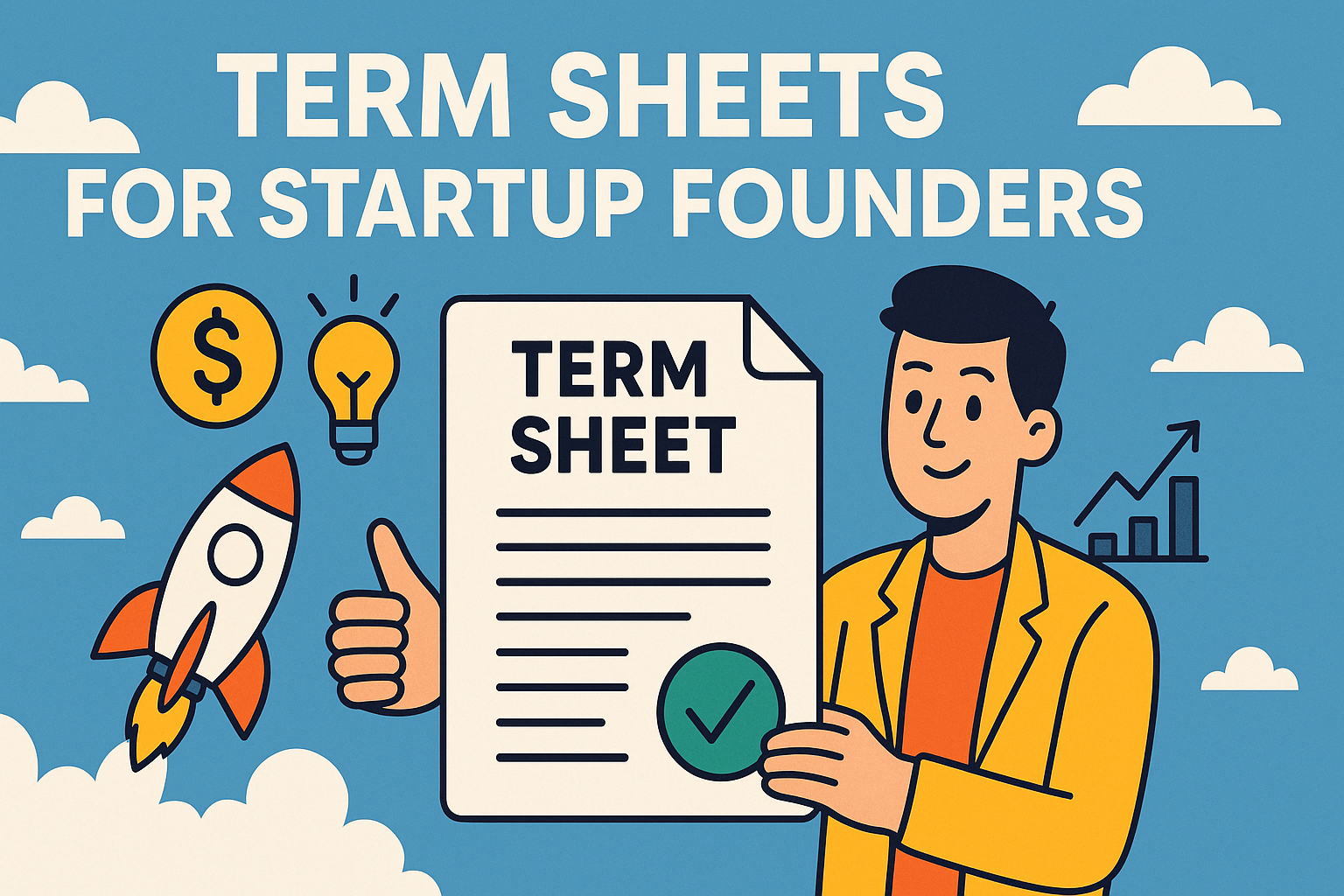Term Sheets for Startup Founders
How to Navigate VC Deals and Protect Your Equity
Raising your first priced round? Before you get lost in the legal jargon, understand this: the term sheet is the document that can define your startup’s future.
It's not just paperwork—it's the framework of your investor relationship, your company’s valuation, and your ownership control. Done right, it accelerates your fundraising. Done wrong, it can cost you leverage, time, and control.
This guide breaks down what startup founders need to know to confidently negotiate a term sheet—plus what to look for, what to push back on, and where hidden traps often live.
What Is a Term Sheet?
A term sheet is a non-binding agreement that outlines the core terms of a proposed equity investment. It’s the investor’s first serious offer and the foundation for your funding round’s legal documents.
Term sheets often appear for a priced round.
It includes details like:
Investment amount
Valuation (pre- or post-money)
Board structure
Ownership rights and liquidation preferences
Control clauses like veto rights and anti-dilution terms
Founder's Insight: Signing a term sheet signals intent. It kicks off legal diligence and fundraising momentum—but it’s not the finish line. Nail the details now before it’s expensive to renegotiate.
When Do Founders Encounter Term Sheets?
Term sheets are used during any priced equity round, such as:
Seed rounds (especially with institutional investors or funds)
Series A and Series B+ rounds
Bridge rounds with preferred equity
If you’re raising using SAFEs or convertible notes, you may not see a traditional term sheet—but some investors still ask for a “mini-term sheet” to confirm valuation caps, discounts, and other key clauses.
Term Sheet Breakdown: What Founders Need to Understand
Here’s a closer look at the most important sections—and what they mean for your business and your equity.
1. Pricing & Ownership Terms
These terms dictate your valuation, ownership, and dilution.
Pre-Money Valuation: The company’s value before new capital is added. Impacts how much equity you’re giving up.
Investment Amount: How much the VC is putting in.
Option Pool Size: Additional shares reserved for employees, often demanded by investors to be included pre-money (which dilutes founders, not them).
🔍 Model different option pool scenarios with a cap table tool before agreeing—this is a common area where founders give away more than they realize.
2. Economic Rights
These define who gets paid—and how much—in an exit or liquidation event.
Liquidation Preference: Who gets paid first in a sale. Standard is 1x non-participating, meaning investors get their money back, no more. Participating preferences or multiples (e.g., 2x, 3x) reduce your upside.
Anti-Dilution Protection: Shields investors in down rounds. Weighted average is common. Full ratchet is a red flag—it resets the share price regardless of the raise amount.
Pro Rata Rights: Allows investors to buy more shares in future rounds to maintain ownership.
3. Control & Governance Rights
This section defines who controls key decisions—and who gets a seat at the table.
Board Composition: Investors may request one or more seats. Try to keep founder control balanced with investor input.
Protective Provisions: These are investor veto rights over major decisions (e.g., raising a new round, selling the company, issuing more stock). Watch for overly broad language.
ROFR & Co-Sale Rights: Investors can match a founder’s attempt to sell shares or tag along in a sale.
Drag-Along Rights: Forces all shareholders to go along with a sale approved by the majority. Needed to prevent blocking—but should be clearly defined.
Advanced Tips for Founders (Especially First-Time or Student Founders)
Get Legal Review: Always, always have legal counsel review your term sheet—ideally someone with startup experience.
Run Cap Table Scenarios: Use online tools to model dilution and ownership changes.
Understand Vesting Triggers: Some investors push for founders to re-vest or extend their vesting. Know when this makes sense—and when it’s a power grab.
Look at Exit Scenarios: Don’t just look at the money coming in—map out what each investor would receive in an exit at $50M, $100M, and $500M.
New Considerations in 2025 Term Sheets
In today's environment, term sheets are starting to reflect new norms, especially in AI, climate tech, and vertical SaaS. Some trends to watch:
More Structured Rounds: Investors are revisiting participating preferences, especially in “hot” sectors with uncertain exits.
AI-Specific Provisions: For companies building with or on top of foundational models, VCs may ask for IP ownership clarity or restrictions around open-source licenses.
Milestone-Based Tranches: Some funds now split capital into performance-driven releases. Make sure milestones are realistic and clearly defined.
Final Thought: Term Sheets Are Leverage Moments
A well-negotiated term sheet can protect your ownership, governance rights, and future fundraising trajectory. But it’s also about building a partnership—one that aligns incentives and supports your long-term vision.
Don’t rush. Ask questions. Model scenarios. Get help.
Because the term sheet isn’t just the start of your deal. It’s the start of your relationship with the people who now own part of your business.
Need More Support to Grow Your Startup?
If you're serious about building and scaling your startup, Pegasus Angel Accelerator offers programs designed to help early-stage founders move faster—with expert mentorship, hands-on resources, and direct connections to investors.
Whether you're launching your first venture or looking to grow an existing company, we have the tools and network to help you level up.
Disclaimer:
This article is for informational purposes only and does not constitute legal, financial, or tax advice. Always consult with a qualified attorney, accountant, or professional advisor before making decisions about incorporating your business, structuring your company, or engaging in fundraising activities.



